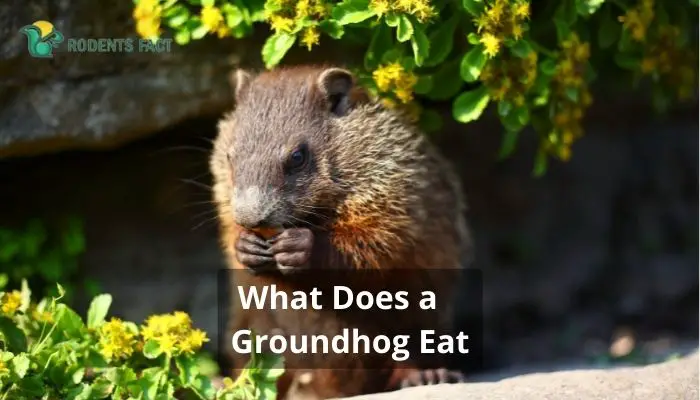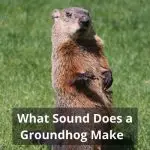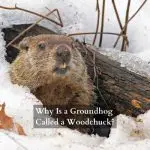What Does a Groundhog Eat | Groundhog Diet and Their Food Nutrition
Do you ever wonder what does a groundhog eat? Groundhogs, like most other rodents, are primarily herbivores and consume vegetation. To survive, groundhogs must consume a broad range of plants, most of which are found naturally.

Farmers and gardeners may get angry with them since they like eating crops that have been intentionally grown. A groundhog’s diet consists mostly of plants like grasses and berries but sometimes includes other things.
They will consume everything from insects to mollusks to baby birds. Due to their infrequent consumption of such items, they are not often classified as omnivores. To survive, groundhogs need to consume plants that are plentiful in their natural habitat.
1. Are Ground Herbivores?
Herbivores consume nothing but plant matter in their diets, which is why groundhogs are considered to be such. These creatures enjoy eating grasses, dandelions, clover, and other plants and weeds.

In addition to this, they will consume agricultural vegetables and plants such as lettuce, carrots, black and red raspberries, and other berries. They will sometimes destroy grubs and beetles, although this is not very common.
Groundhogs have a diverse diet, which may challenge gardeners and others who cultivate their fruits and vegetables at home. A significant amount of food must be consumed by groundhogs before they can enter hibernation, and these animals are not capable of comprehending the idea of private property.
2. What Types of Food Do Groundhogs Eat?
Groundhogs consume a range of local flora. Seasons and neighboring crops might influence their nutrition. Dandelions, sorrel, clover, and alfalfa are groundhog favorites.
These lush greens comprise the majority of a wild groundhog’s diet. Wild groundhogs consume grasses, berries, pears, apricots, and cherries. If a groundhog burrow is near a farm or garden, it may eat the veggies.

Lettuce, maize, carrots, beans, peas, zucchini, and celery are favorites. Groundhogs consume grasshoppers, crickets, snails, and grubs. They will consume young birds if they fall from a nest.
3. Do Groundhogs Eat Fruits?
Fruits appeal to groundhogs because of their sugary flavor and high-calorie content. Here I have published an in-depth post on the fruits that groundhogs eat.

Summarized below is a list of the best fruits preferred by groundhogs:
- Apples
- Cherries
- Grapes
- Blueberries
- Melons
- Peaches (they love them!)
- Pears
- Plums
- Oranges
- Strawberries
4. What Are The Most Common Groundhog Meals?
Groundhogs get most of their nutrition from grasses, clover, alfalfa, and dandelion greens. Groundhogs like eating fruits and vegetables grown in gardens, including berries, apples, lettuce, maize, and carrots, among other things.

5. What Animals Do Groundhogs Consume?
Various eating habits of a groundhog preclude us from labeling them complete herbivores. This is even though groundhogs are thought of as being mostly herbivores.
This indicates that it is not unusual for groundhogs to consume tiny animals, such as the following:
- Juvenile birds
- Birds eggs
- Snails
- Grasshoppers
- Crickets
- Grubs
- Bugs
- Other similar-sized mammals and birds
Groundhogs may consume the young birds that they stumble upon by coincidence. In addition to eggs, groundhogs will consume big insects such as grasshoppers and June bugs for food.
Nevertheless, plants will continue to make up a significant portion of a groundhog’s diet. As a result, groundhogs can survive for extended periods without eating other than herbs and green.
6. What is Groundhog Diet During Summer?

As summer approaches, groundhogs switch to a diet of fresh produce. Their favorite summertime treats are blueberries, pears, applesauce, maize, and green beans. Additionally, during the warmer months, groundhogs will consume insects.
7. What Do Groundhogs Eat in the Grass?
In areas with dense vegetation, groundhogs are common. They do this for several reasons, including the need to camouflage themselves from humans and other predators and the desire to feast on any grass-dwelling flowers or insects they might find.
The shorter grass in your yard is a favorite food source for groundhogs. Groundhogs will eat the tall grass and plants in your yard if they can. If you want to prevent groundhogs from making your yard their home, you might try trimming back any overgrown vegetation.

Likewise, long grasses and gardens are popular places for groundhogs to use as tunnel entrances. By doing so, they do not have to go too far from their tunnels to conceal and get their food.
Removing tall grass may deter groundhogs and prevent them from accessing your yard.
Read More: How To Tell How Old A Baby Groundhog Is- Size, Weight, and Attributes
8. What Do Groundhogs Eat in the Spring?
In the early part of spring, when groundhogs have just recently emerged from their hibernation, there are few plants for them to consume. As a result, most of their diet consists of tubers, bugs, and bark.

Groundhogs consume a wide variety of vegetation, especially flowers, fruits, and vegetables, as the spring season progresses. During the spring, they like snacking on things like daffodils, clover, grasses, and different buds from trees, among other things. In the springtime, groundhogs have also been seen eating several mushrooms.
9. What Do Groundhogs Eat Before Hibernation?
An animal can survive off of the energy it has stored when it enters a state of hibernation, characterized by inactivity and a lowered metabolic rate. Consuming a wide variety of plant foods, such as fruits, vegetables, and nuts, is the first step groundhogs take in preparing their bodies for hibernation.
They will eat a lot of vegetables, but they will also strive to up the number of nuts and insects they ingest than they usually would because these foods are richer in lipids and protein.
10. What Do Groundhogs Eat in the Winter?
Since groundhogs hibernate throughout the winter months, you will not find their overeating. March is the traditional month in which they will become active again.

However, suppose they come out of “false hibernation” around the beginning of February, which means they awoke earlier than usual. In that case, they will consume whatever food they can find since there is not much available at the moment of the year.
If they can locate them, they may consume small animals, nuts, roots, and insects for food.
11. How Do Groundhogs Forage For Food?
When living in the wild, groundhogs must depend on their excellent instincts to help them identify food. Groundhogs rely heavily on their senses of sight, taste, and hearing.
However, hearing is more beneficial for spotting danger than locating a meal. It has been reported that they can detect foodprints at a distance of more than 500 yards.
The groundhog’s keen eyesight allows it to detect distant movement. Once groundhogs emerge from their tunnels, they use their sense of smell and sight to find food.

Burrows is more often seen in regions where groundhogs have easy access to food. This implies they will often attempt to breach obstacles such as fences to access the vegetation on either side.
Even though they are most active during the day, they often only come out to forage in the early morning or late evening. Groundhogs are known to bring back additional food to their burrows after a day of foraging. Their need to stockpile food for the cold season explains why they keep returning to their holes for more.
12. Do Groundhogs Eat Any Human Foods?
Yes, they will consume human waste if it has found its way out of the trash can or if it has been left outside the home for any other reason.
Peanut butter, bread, chips, almonds, and candy are some of the foods that groundhogs will consume. They are aware, despite this, that certain items are not healthy for them to consume.

However, they would prefer to break into your garden and consume the planted veggies.
13. What Is the Damage Caused by the Groundhog Diet?
Daily, groundhogs often ingest the equivalent of one-third of their body weight in plants. In addition to burrowing, other evidence of damage includes crops that have been hollowed out and biting marks on vegetables.
Both high-frequency sound repellents and do-it-yourself fences around crops that groundhogs prefer to consume may help keep these pests away. However, your best chance is to get in touch with the experienced technicians at Orkin Canada.
14. Do Groundhogs Eat Broccoli?
Yes. Although they do consume broccoli, groundhogs prefer to eat other vegetables since they are simpler to digest. Even though it is rich in protein, vitamins, minerals, and soluble fiber, broccoli is classified as a member of the family known as Brassicaceae.

The digestion of an excessive amount of fibers necessitates a great deal of energy from the groundhog. The digestion of fruits or tubers requires less energy, which is why groundhogs often choose them.
15. Do Groundhogs Eat Cucumbers?
Groundhogs indeed consume cucumbers. They will consume it regardless of the season, although owing to the warmer temperatures during the summer, they seem to enjoy it more than during other times of the year.
Groundhogs will consume in-ground and container-grown cucumbers since it makes no difference to them whether the plant is in the ground or a container. They will consume the foliage of the plants as well as the fruit.
16. Do Groundhogs Eat Through Wood?
They are not like beavers, by the way. They may eat wood, but it does not agree with their digestive systems. But there is a good reason why two names know woodchucks: they are often seen munching on tree bark or saplings in the early spring when insects hide out in the wood.
17. What are Foods To Avoid When Feeding Groundhogs?
Herbs, spices, and strongly scented flowers are just some of the dietary additives that drive groundhogs crazy. The list below may include some unexpected things.
According to the Farmers’ Almanac, thyme, rosemary, thyme, mint, cilantro, sage, and chives are among the herbs groundhogs find offensive. However, these seasonings and herbs are fantastic for human health.

Although groundhogs like eating flowers, there are some varieties they will avoid. Some examples are lily of the valley, lavender, hellebores, and yarrow.
- Strong-smelling and poisonous to groundhogs, these blooms are a terrible choice. Groundhogs do not like hellebores due to their rough leaves.
- Animals, especially groundhogs, may die from ingesting lily-of-the-valley.
- In case you were wondering, lavender will flourish if planted in a garden. The strong aroma of lavender deters groundhogs. Us humans are olfactory aficionados.
- Another flower that is unappealing to groundhogs is the white sweet alyssum, which has a pleasant fragrance.
According to the Farmers’ Almanac, the strong odor of garlic is offensive to groundhogs. You may relax knowing that these pests will avoid your garlic crops if you plant them in your garden.
Again, the pungent odors of black pepper and cayenne pepper make groundhogs wary. In addition to using these spices in your garden, you can apply them to their nests to scare them away.
Although groundhogs often avoid those above, they may resort to eating them if they are starving.
Final Words
This is everything on “what does a groundhog eat.” Despite their cute look, groundhogs can be pesky pests that feast on garden plants and vegetables..
Basically, all that a groundhog does is eat and sleep. While their destructive feeding habits and invasive nature may be annoying, their unique capacity to hibernate for many months is hard to dismiss. You need not be alarmed if you happen to stumble or encounter one of these critters in the wild.




